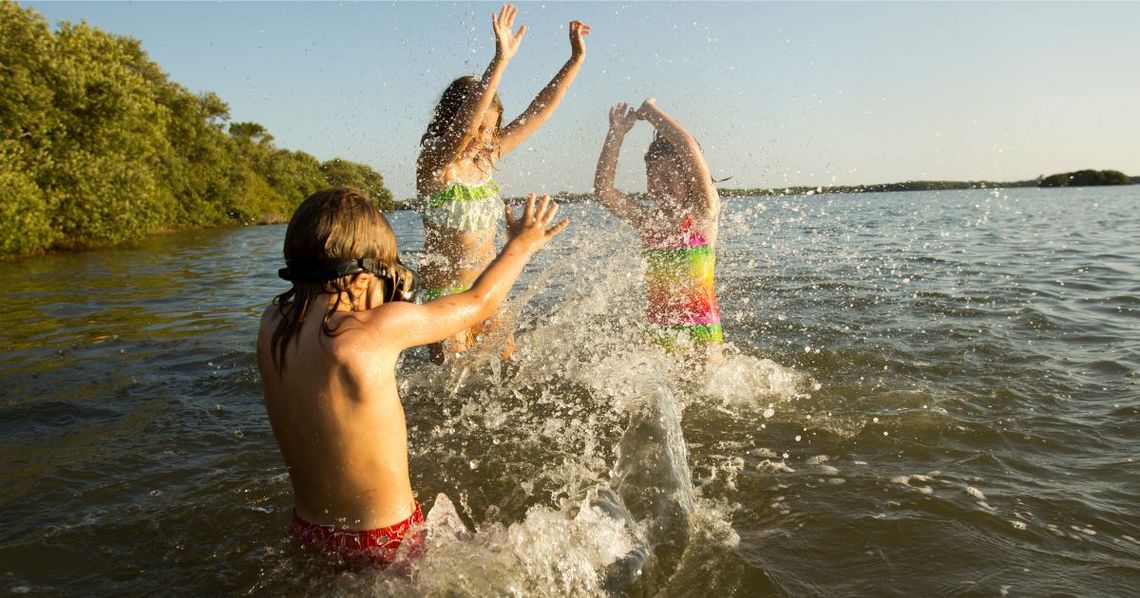Swimming and water sports in natural settings

Summertime brings many people to the region's lakes and rivers for swimming and water sports such as paddle boarding, water skiing, and kayaking.
But water quality can be affected in a variety of ways:
- Wastewater contamination: Wastewater can contain microorganisms such as bacteria, viruses, and parasites.
- Runoff during heavy rains: Heavy rainfall can carry contaminants into bodies of water.
People at Risk
Children, the elderly, and people with weakened immune systems are more vulnerable to contaminated water and should therefore be even more vigilant.
Health Impacts
Microorganisms in water can cause health problems. The most common are:
- gastroenteritis (diarrhea, nausea, vomiting)
- ear infections
- eye, nose, and throat infections
- skin disorders
While swallowing contaminated water is the main way people are exposed to these microorganisms, they can also enter the body through the ears, eyes, nose, or skin abrasions.
Activities involving significant body contact with water (e.g., swimming, waterskiing, and paddle boarding) are more risky than secondary activities such as water sports (e.g., canoeing, kayaking, and rowing).
Protecting Yourself
We recommend swimming in monitored areas where water quality is regularly measured and displayed. You can check the water quality of the beaches listed at Programme Environnement-Plage (French). Unlisted beaches may also be monitored. Check with the municipality or beach manager.
You should always take these measures to protect yourself:
- Avoid swallowing water or getting water in your mouth.
- Avoid swimming if you have an open wound or a skin infection.
- Avoid swimming if the water looks "greenish", especially if there is scum. This could be blue-green algae (cyanobacteria).
- Avoid swimming within 24 hours of heavy rain or continuous rain lasting an entire day.
- Wash your hands after swimming and before eating.
- Take a shower after your activity.
Limiting Water Contamination
Please do the following to avoid contaminating the water:
- Don't go swimming if you have diarrhea.
- Change diapers regularly. A diaper specially designed for swimming should be used.
- Avoid feeding waterfowl (ducks, gulls, etc.) near bodies of water, as they are a source of contamination.
Swimmer's Itch
When swimming in certain lakes, small larvae called "cercariae"—almost invisible to the naked eye—might be present in the water. These larvae, originating from aquatic birds, stick to the skin until the bather leaves the water. They can cause swimmer's itch.
Health Impacts
When the skin dries out in the sun, cercariae burrow into the skin but then quickly die causing the following:
- The appearance of small red patches on the skin shortly after swimming. These patches can resemble mosquito bites, and affect any uncovered part of the body that has been in contact with water.
- Severe itching that can last up to ten days.
Protecting Yourself
Taking the following actions can help prevent swimmer's itch:
- If possible, avoid beaches where cases of swimmer's itch have been reported.
- Limit the time you spend in the water to just a few minutes.
- Swim in deeper water, if possible.
- Avoid letting children wade at the water's edge.
- When you come out of the water, dry your skin by rubbing it vigorously with a towel. Avoid letting your skin dry out in sunlight or open air.
- If possible, shower as soon as you get out of the water.
- Change your clothes as soon as you have finished swimming.
- Inform other bathers if you are affected by dermatitis.
- Avoid feeding waterfowl.
Useful Links
Québec.ca
- Health problems associated with bathing waters
- Preventing health problems associated with bathing waters
- Preventing health problems associated with blue-green algae blooms
Ministère de l’Environnement, de la Lutte contre les changements climatiques, de la Faune et des Parcs
- Programme Environnement-Plage (French)
Ministère de la Santé et des Services sociaux
INSPQ
Ces conseils sont émis par la Direction de santé publique de l’Estrie.
